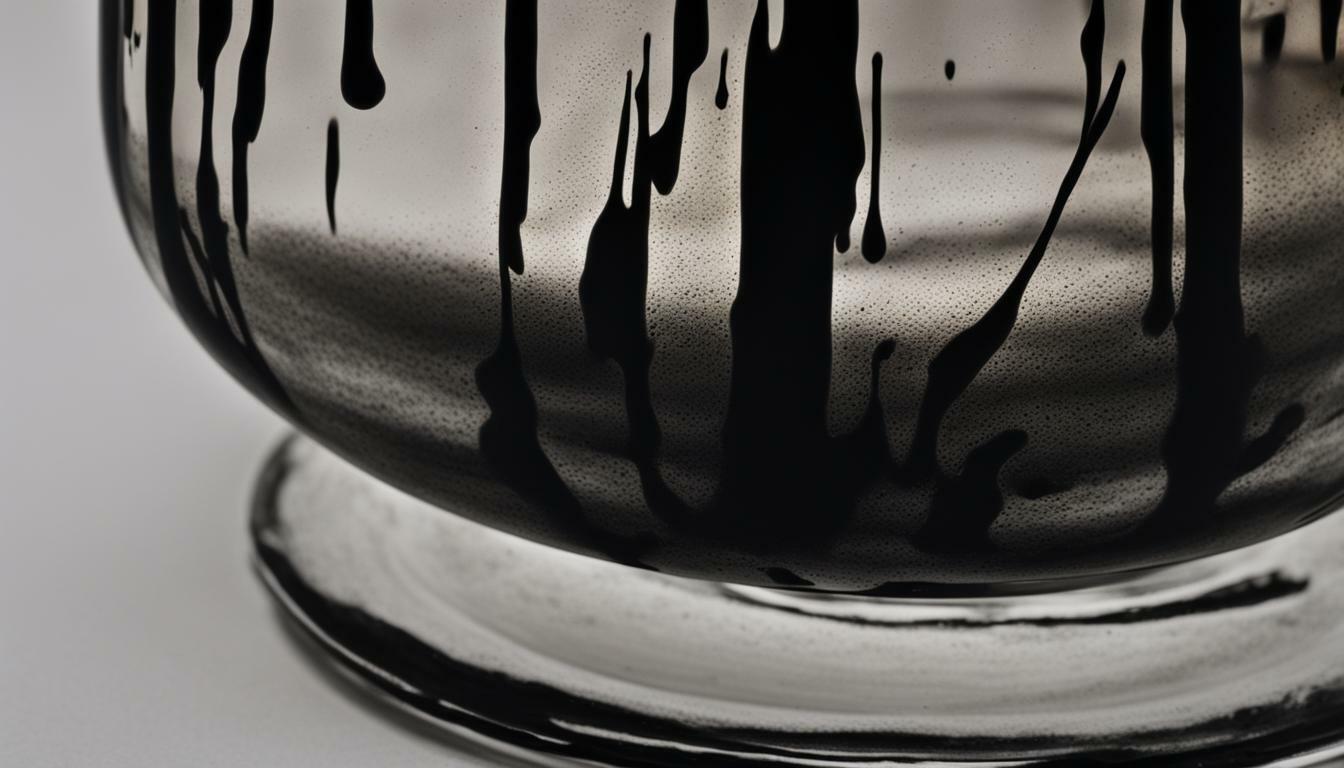If you have ever lit a candle and noticed that the glass container gradually turns black, you may wonder what causes this phenomenon. The black residue on the candle glass, also known as candle soot, is a common occurrence that can be attributed to several factors.
One of the main causes of candle glass turning black is soot, which is the result of incomplete combustion. When a candle burns, the flame releases carbon particles into the air. These particles then come into contact with the cooler surface of the glass and form a black residue.
The amount of soot produced can be influenced by various factors, including the type of wax used, the size and material of the wick, draft and airflow, burning conditions, candle additives, candle quality, and even the size and burn time of the candle itself.
Key Takeaways:
- Candle glass turning black is caused by soot, which is the result of incomplete combustion.
- Several factors can contribute to the amount of soot produced, including the type of wax used, the size and material of the wick, draft and airflow, burning conditions, candle additives, candle quality, and the size and burn time of the candle itself.
The Role of Wax in Soot Production
The type of wax used in the candle can greatly affect the amount of soot produced. Different waxes have different chemical compositions, which can impact the combustion process and the formation of soot. Let’s take a closer look at three common types of wax used in candles: paraffin wax, soy wax, and beeswax.
Paraffin Wax: Paraffin wax is one of the most widely used waxes in candle making. It is derived from petroleum and has a high carbon content, which means it releases more soot when burned compared to other waxes. The combustion of paraffin wax can result in black residue on the glass, leading to the glass turning black over time.
Soy Wax: Soy wax is a natural alternative to paraffin wax. It is made from soybean oil, which has a lower carbon content and generally produces less soot when burned. Candles made from soy wax are known for their cleaner burn and reduced soot formation. Choosing candles made from soy wax can help minimize the black residue on the glass.
Beeswax: Beeswax is another natural wax option, produced by bees. It has a higher melting point than paraffin wax and soy wax, resulting in a slower burn rate. Beeswax candles tend to produce minimal soot and are often preferred by those seeking a cleaner and healthier candle-burning experience.
| Wax Type | Source | Carbon Content | Soot Production |
|---|---|---|---|
| Paraffin Wax | Petroleum | High | More soot |
| Soy Wax | Soybean oil | Medium | Less soot |
| Beeswax | Produced by bees | Low | Minimal soot |
By understanding the different types of wax used in candles, you can make informed choices about the candles you burn. Opting for candles made from soy wax or beeswax can help reduce the amount of soot produced, minimizing the black residue on your candle glass.
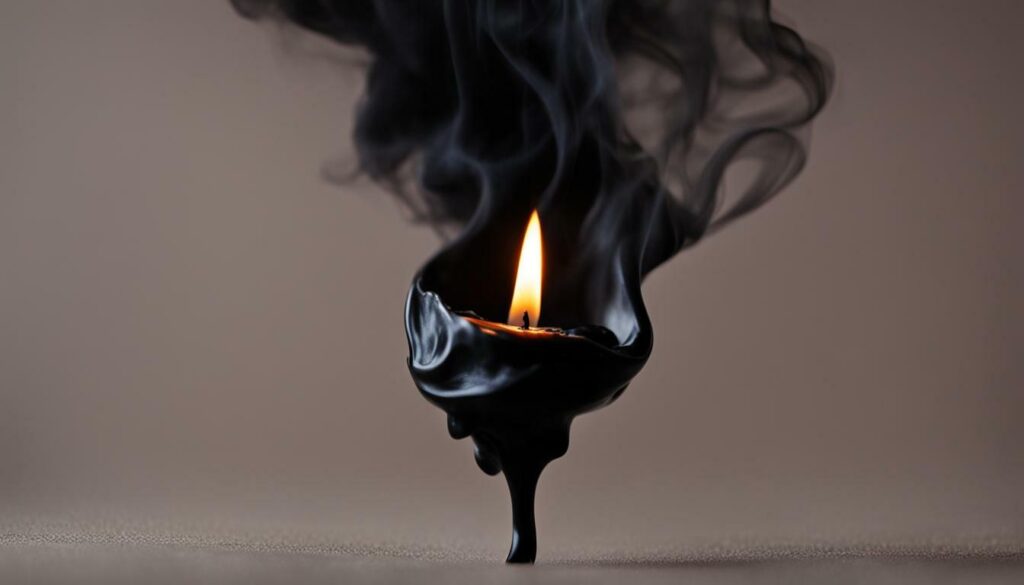
The type of wax used in the candle can greatly affect the amount of soot produced.
The Influence of Wick Size and Material
The size and material of the wick also play a role in the production of soot. When it comes to wicks, different sizes and materials can affect the amount of soot that is generated during the burning process. It’s important to understand how these factors contribute to soot production so that you can make informed choices when selecting candles.
Thicker or longer wicks tend to produce more soot compared to thinner or shorter wicks. This is because a larger wick can create a larger flame, which can lead to incomplete combustion. When combustion is incomplete, more carbon particles are released into the air, resulting in black residue on the candle glass.
It’s also worth considering the material of the wick. Cotton wicks, for example, are commonly used in candles and can contribute to soot production. Cotton wicks have a higher chance of producing soot because the fibers may not burn as cleanly as those made from natural materials.
On the other hand, candles with wicks made from natural fibers, such as hemp or paper, tend to produce less soot. These wicks are often designed to burn more efficiently and cleanly, reducing the amount of black residue that forms on the candle glass.
When choosing a candle, it’s important to consider the size and material of the wick. Opting for candles with thinner or shorter wicks made from natural fibers can help minimize the production of soot. This can result in a cleaner burn and reduce the amount of black residue left on the glass.
The size and material of the wick play a crucial role in determining the amount of soot generated during the burning process. Thicker or longer wicks, such as those made from cotton, tend to produce more soot compared to thinner or shorter wicks made from natural fibers. By choosing candles with smaller, natural fiber wicks, you can promote a cleaner burn and reduce the occurrence of black residue on your candle glass.
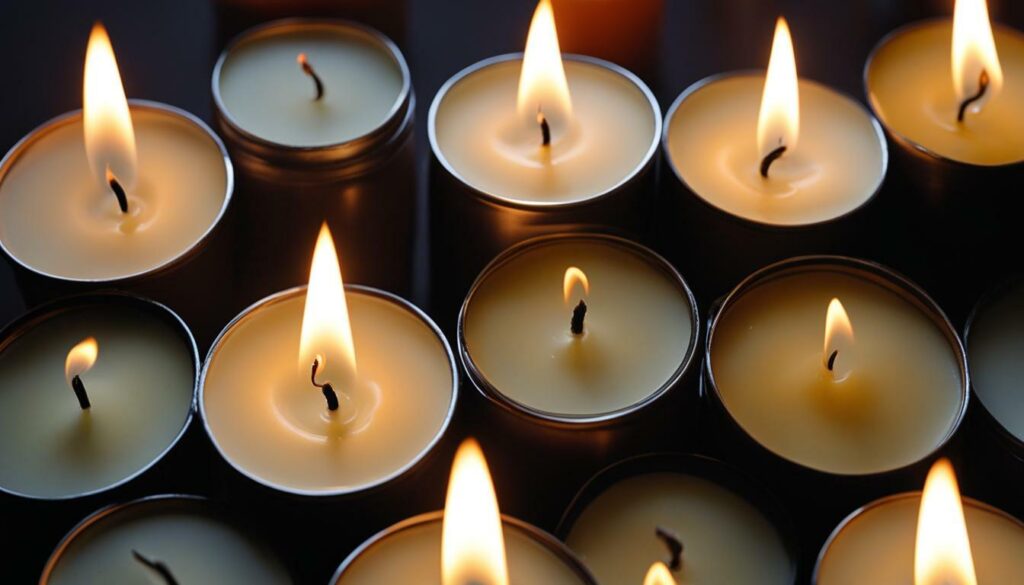
| Wick Size | Soot Production |
|---|---|
| Thicker or longer wicks | Higher |
| Thinner or shorter wicks | Lower |
When it comes to selecting candles, paying attention to the wick size and material can make a difference in maintaining a clean burn. By opting for candles with smaller, natural fiber wicks, you can minimize soot production and enjoy a more pleasant candle-burning experience.
Drafts and Airflow
Candles exposed to drafts or high airflow are more likely to produce soot. When there is a disturbance in the airflow around the candle, it can disrupt the balance between oxygen and fuel, leading to incomplete combustion.
“Airflow can impact the way a candle burns and the amount of soot it produces. Excessive airflow can cause the flame to flicker and dance, which can introduce more oxygen into the flame. When there is an abundance of oxygen and not enough fuel, incomplete combustion occurs, resulting in the formation of soot.” (Source 1)
Think of it as a campfire that is blowing in the wind. The flame becomes unsteady and produces more smoke and soot. The same principle applies to candles. It’s important to create an environment with minimal drafts to allow for cleaner burning.
By reducing drafts and controlling airflow, you can maintain the oxygen and fuel balance necessary for complete combustion. This will help prevent the accumulation of soot on the candle glass.
Now, let’s take a closer look at how drafts and high airflow affect candle burning:
| Drafts and High Airflow | Oxygen and Fuel Balance |
|---|---|
| Drafts | When there is a draft, such as an open window or a fan blowing directly on the candle, it can cause the flame to flicker and become unstable. This disrupts the balance of oxygen and fuel, resulting in incomplete combustion and increased soot production. |
| High Airflow | Similarly, high airflow in a room can disturb the flame and lead to the same issues as drafts. It’s important to keep candles away from areas with strong air currents to ensure a steady burn and minimize the formation of soot. |
 | |
Remember, to maintain a clean burn and reduce the likelihood of black residue on your candle glass, it’s crucial to create an environment with minimal drafts and airflow. This will help maintain the proper balance between oxygen and fuel, promoting complete combustion and minimizing soot formation.
Tips for Proper Burning Conditions
The way you burn your candle can also contribute to the amount of soot produced. By following some simple guidelines, you can create optimal burning conditions that minimize soot formation and help your candle burn cleanly and evenly.
Burning Conditions
Ensure that you allow your candle to burn long enough for the entire surface of the wax to melt evenly. This helps prevent the development of a “memory ring,” which can cause uneven burning in subsequent uses. Aim for at least one hour of burn time per inch in diameter. For example, if you have a 3-inch diameter candle, allow it to burn for at least 3 hours.
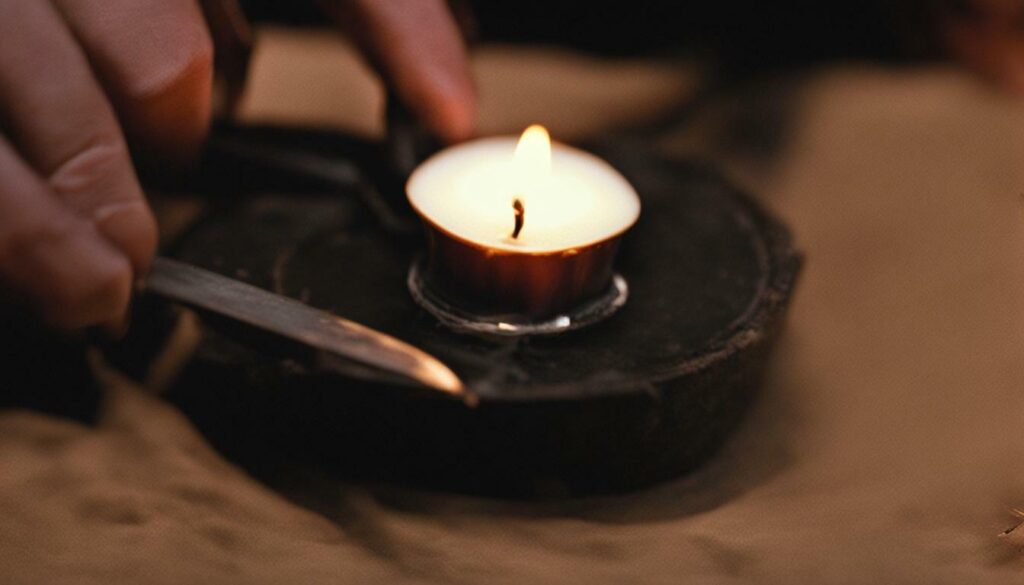
Wick Trimming
Regularly trimming the wick to a length of about ¼ inch before each use helps maintain a clean and even burn. A long wick can produce more soot and cause the flame to become larger, leading to increased heat and the potential for glass discoloration. Use a wick trimmer or scissors to trim the wick, ensuring that it is always at a safe and appropriate length.
Even Burn
To achieve an even burn and prevent the candle from tunneling, make sure to maintain a consistent burn pattern. Avoid extinguishing the candle too soon, as this can result in a smaller, unevenly melted wax pool. Allow the candle to burn long enough to reach the edges of the container each time you light it. This promotes an even burn and reduces the likelihood of soot formation.
“Proper candle burning can significantly reduce the amount of soot produced, prolong the life of the candle, and ensure a clean and even burn.”
Following these burning conditions helps optimize the performance of your candle and minimizes the risk of black residue on the glass. By taking care of your candle and creating ideal burning conditions, you can enjoy a beautiful, soot-free experience while filling your space with a delightful fragrance.
The Impact of Candle Additives
Certain additives in candles can increase the soot production. When choosing candles, it’s important to consider the ingredients and additives used in their formulation. Candle additives, such as fragrance oils and dyes, can contribute to the formation of soot on candle glass. Understanding the impact of these additives can help you make informed choices for a cleaner burning experience.
Fragrance oils are commonly used in candles to provide a pleasant scent. However, some fragrance oils contain chemicals that can increase the production of soot when burned. The chemicals in these oils can affect the combustion process, leading to incomplete burning and the formation of black residue on the candle glass. Opting for candles with fewer additives or fragrance-free options can help reduce soot formation.
In addition to fragrance oils, dyes used to color candles can also contribute to soot production. Certain dyes contain carbon-based pigments that can release carbon particles when burned, increasing the likelihood of soot formation. Choosing candles with natural or non-toxic dyes can minimize the impact on soot production.
It’s worth noting that not all candles with additives will result in excessive soot. Many reputable candle manufacturers carefully select their additives to minimize their impact on combustion and soot production. However, it’s always a good idea to check the ingredient list and opt for candles made from pure, high-quality ingredients whenever possible.
“Certain additives in candles can increase the soot production.”
| Additive Type | Impact on Soot Production |
|---|---|
| Fragrance Oils | Can increase soot formation when containing chemicals that affect combustion. |
| Dyes | May release carbon particles when burned, contributing to soot production. |
| Natural Additives | Choosing candles with fewer or natural additives can reduce soot formation. |
Expert Tip: Minimizing Soot from Additives
To minimize the impact of additives on soot production, consider candles made with natural fragrance oils and dyes derived from plant-based sources. These alternatives are often less likely to contribute to excessive soot formation. Additionally, opting for unscented candles or those with minimal additives can also help create a cleaner burning experience.
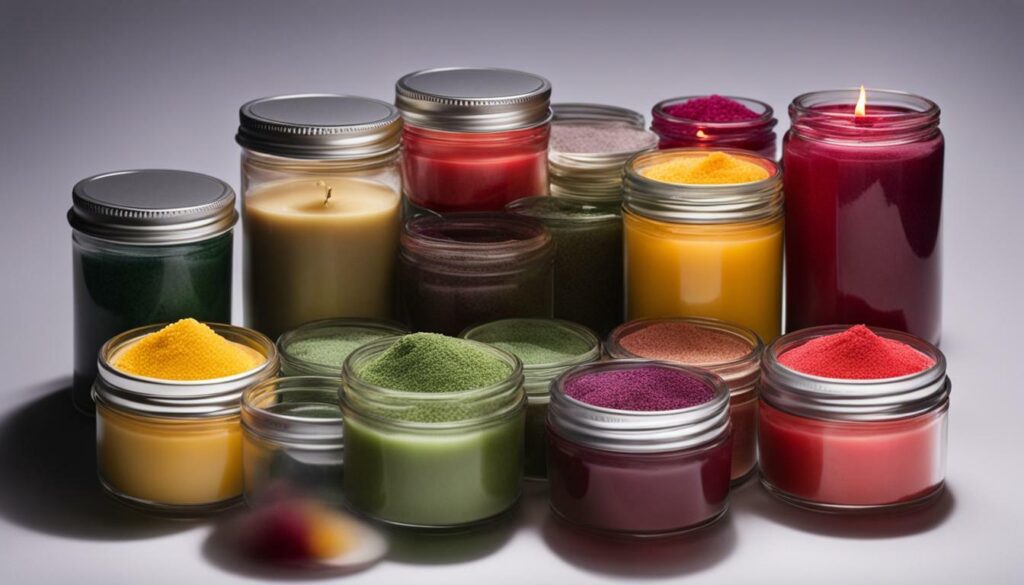
- Choose candles made with minimal additives or natural fragrance oils.
- Opt for candles with non-toxic or plant-based dyes.
- Consider unscented candles to reduce the potential for excessive soot formation.
Candle Quality and its Impact on Soot Production
The quality of the candle can also impact soot production. In fact, the impurities present in lower-quality candles can contribute to increased black residue on candle glass. Choosing higher-quality candles made from pure ingredients can help minimize the amount of soot produced. These candles are typically made with cleaner-burning waxes and are free from additives that may contribute to soot formation. Furthermore, higher-quality candles are often crafted with meticulous attention to detail, ensuring a more even burn and reducing the likelihood of blackening the glass.
To understand how the quality of a candle can affect soot production, it is important to consider the presence of impurities. Lower-quality candles may contain additives, such as low-grade fragrance oils or dyes, which can release particles into the air when burned. These particles can contribute to the formation of soot and lead to black residue on the glass. Opting for candles with fewer additives or fragrance-free options can significantly reduce the likelihood of soot formation.
Did you know? The quality of the candle can also impact soot production. Lower-quality candles may contain impurities, such as fragrance oils or dyes, that contribute to black residue on candle glass.
Additionally, the type of wax used in a candle can affect its quality and soot production. Higher-quality candles often utilize cleaner-burning waxes, such as soy or beeswax, which have lower carbon content compared to traditional paraffin wax. Paraffin wax, commonly used in lower-quality candles, contains higher levels of carbon and can lead to increased soot production. Choosing candles made from cleaner-burning waxes can help minimize black residue on the glass.
When selecting a candle, it is also important to consider the wick size and material. Lower-quality candles may feature thicker or longer wicks made from materials like cotton, which can contribute to increased soot production. Natural fiber wicks, on the other hand, tend to burn more cleanly and produce less soot. Opting for candles with natural fiber wicks can help reduce the likelihood of blackening the glass.
Ensuring optimal burning conditions is another factor to consider when it comes to reducing soot production. Proper candle care, such as allowing the candle to burn long enough for the surface to melt evenly and trimming the wick to an appropriate length, can promote a clean and even burn, minimizing the formation of soot. Additionally, avoiding drafts and high airflow around the candle can help maintain the balance between oxygen and fuel, preventing incomplete combustion and reducing soot formation.
By considering the quality of the candle, avoiding candles with impurities, choosing cleaner-burning waxes, and practicing proper burning techniques, you can significantly reduce the black residue on your candle glass. Remember, investing in higher-quality candles not only enhances your candle experience but also helps maintain a clean and soot-free environment.
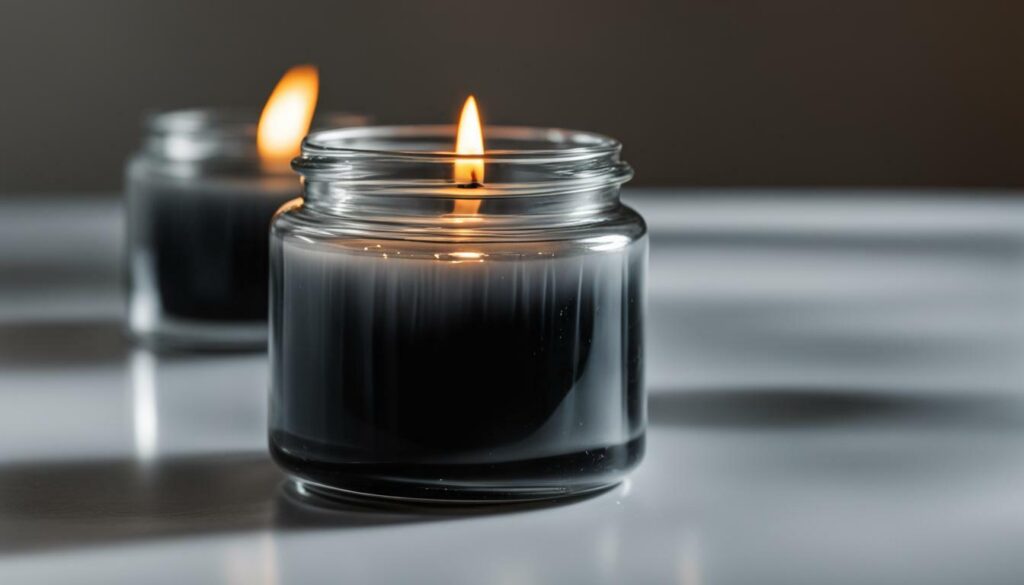
The Impact of Candle Size and Burn Time
The size of the candle and its burn time can also affect the amount of soot produced. Larger candles with longer burn times tend to generate more soot compared to smaller candles with shorter burn times. This is because larger candles have a larger surface area, allowing for more fuel to be consumed and potentially leading to incomplete combustion.
Burning a candle for an extended period of time can also contribute to increased soot formation. When a candle burns for too long, the wick can become too long and start to curl, resulting in a larger flame. This can disrupt the balance of oxygen and fuel, leading to inefficient combustion and the production of more soot.
To minimize the amount of soot produced, it is recommended to follow the manufacturer’s guidelines for burn times. This ensures that the candle burns evenly and prevents excessive wick length. Trimming the wick to the recommended length before each use can also help promote a clean and efficient burn.
Did you know? Smaller candles with larger surface areas tend to burn more cleanly, resulting in less soot formation.

| Candle Size | Burn Time | Soot Production |
|---|---|---|
| Large | Long | Higher |
| Small | Short | Lower |
As shown in the table above, larger candles with longer burn times tend to result in higher soot production, while smaller candles with shorter burn times produce less soot. It’s important to consider the size and burn time of the candle when aiming for a clean and soot-free burn.
Conclusion
Understanding why your candle glass is turning black requires considering various factors. By implementing some candle cleaning tips and practicing proper candle care, you can prevent glass discoloration from candles and enjoy a clean and soot-free burn.
First and foremost, it is essential to maintain optimal burning conditions. Allow your candle to burn long enough for the entire surface to melt evenly, as this helps prevent the formation of a memory ring. Remember to trim the wick to an appropriate length before each use, around 1/4 inch, to promote a clean and even burn.
Consider the type of wax used in your candles. Paraffin wax, commonly found in many commercial candles, tends to produce more soot due to its higher carbon content. Opt for candles made from soy wax or beeswax, as these alternatives generally produce less soot and are considered more environmentally friendly.
Another factor that influences soot production is the size and material of the wick. Thicker or longer wicks, especially those made from cotton, can contribute to increased soot formation. Instead, choose candles with natural fiber wicks, which tend to produce less soot.
Be mindful of drafts and high airflow around your burning candles. These can disrupt the balance of oxygen and fuel, leading to incomplete combustion and more soot on your candle glass. Position your candles away from drafty areas and ensure a steady airflow to keep your candles burning cleanly.
Additionally, consider the impact of candle additives. Fragrance oils and dyes commonly found in scented candles can contribute to soot production. If minimizing soot is a priority, consider opting for fragrance-free candles or those with fewer additives.
Quality matters when it comes to candles. Higher-quality candles made from pure ingredients tend to produce less soot and provide a cleaner burn. Investing in well-crafted candles can help reduce the chances of your candle glass turning black.
Lastly, keep in mind the size of your candles and their burn time. Smaller candles with larger surface areas tend to burn more cleanly. Follow the manufacturer’s guidelines for burn times to avoid excessive soot production and prolong the life of your candles.
To maintain the beauty of your candle glass and prevent it from turning black, it is crucial to consider these various factors and implement proper candle care. By following these candle cleaning tips and taking preventive measures, you can enjoy a pristine and soot-free atmosphere while enjoying the warm glow of your favorite candles.
FAQ
Q: Why does candle glass turn black?
A: Candle glass turns black due to soot, which is the result of incomplete combustion.
Q: What type of wax produces more soot?
A: Paraffin wax, which has a higher carbon content compared to soy or beeswax, tends to produce more soot.
Q: How does wick size and material influence soot production?
A: Thicker or longer wicks, especially those made from cotton, can produce more soot compared to natural fiber wicks.
Q: Can drafts and high airflow affect soot formation on candle glass?
A: Yes, drafts and high airflow can disrupt the balance of oxygen and fuel, leading to incomplete combustion and increased soot formation on candle glass.
Q: What are some tips to reduce soot formation?
A: To reduce soot formation, allow the candle to burn long enough for the surface to melt evenly, trim the wick, and promote a clean and even burn.
Q: Do candle additives contribute to soot formation?
A: Yes, certain additives like fragrance oils or dyes can contribute to soot formation. Consider using candles with fewer additives or fragrance-free options.
Q: How does candle quality affect soot production?
A: Higher-quality candles made from pure ingredients tend to produce less soot compared to candles with impurities.
Q: Can the size and burn time of a candle affect soot production?
A: Yes, smaller candles with larger surface areas tend to burn more cleanly. Follow the manufacturer’s guidelines for burn times to minimize soot production.
Q: What are some candle cleaning tips to prevent glass discoloration?
A: Proper candle care, such as trimming the wick and ensuring an even burn, can help prevent glass discoloration.
